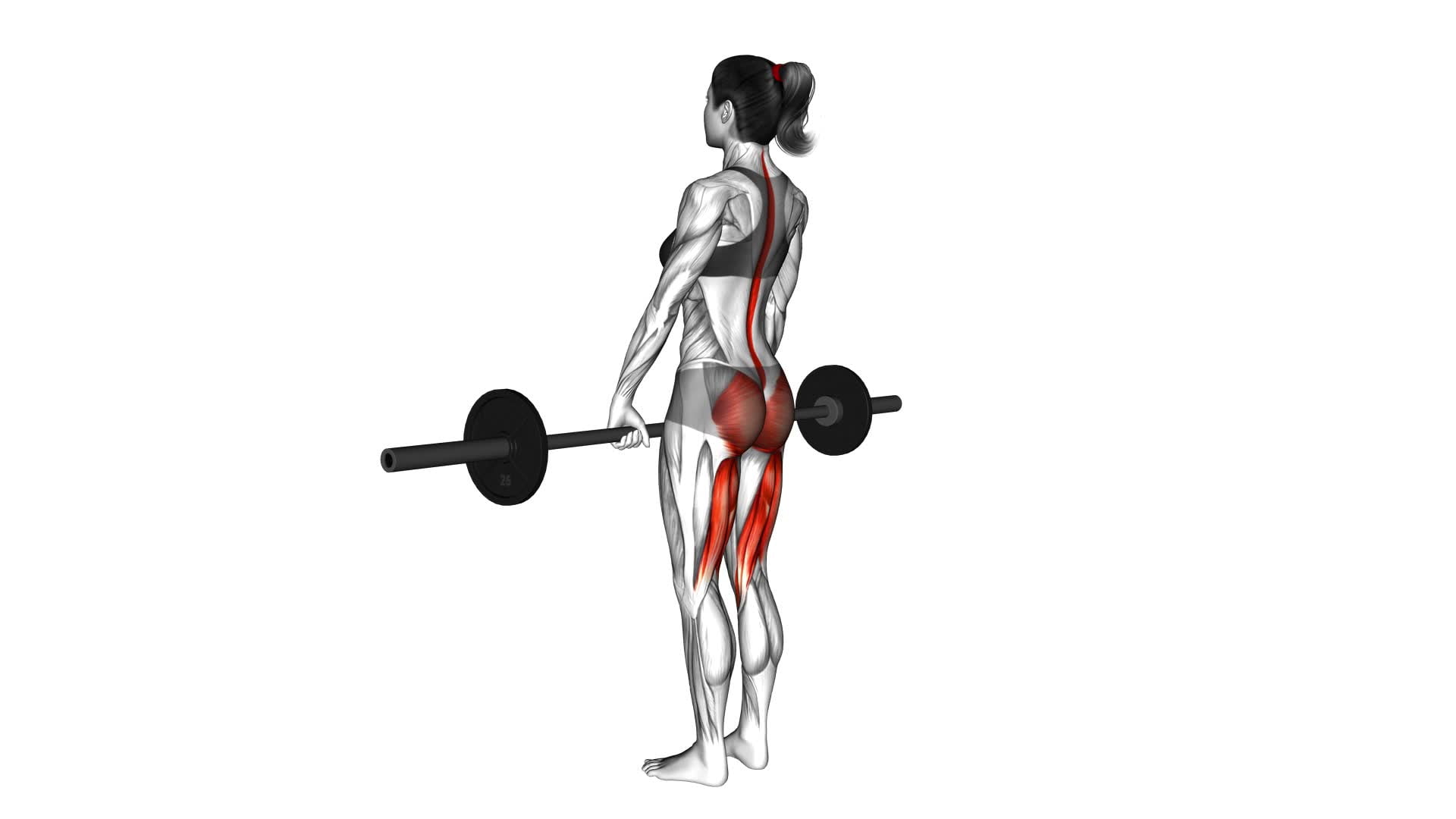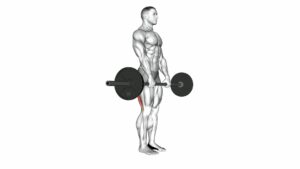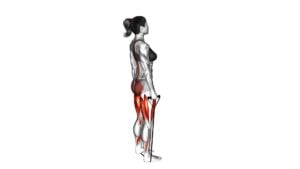Barbell Straight Leg Deadlift (female) – Video Exercise Guide & Tips

Are you ready to take your leg workout to the next level?
Watch This Exercise Video
In this video exercise guide, we'll show you how to perform the barbell straight leg deadlift. This powerful move targets your hamstrings, glutes, and lower back, helping you build strength and definition.
With proper form and technique, you'll maximize your results and avoid common mistakes.
So grab a barbell and get ready to feel the burn!
Let's dive into the world of barbell straight leg deadlifts.
Key Takeaways
- Barbell Straight Leg Deadlifts target the hamstrings, glutes, and lower back.
- Proper form and technique are crucial to avoid injury and maximize results.
- Gradually increasing weight can help build muscle and challenge yourself.
- Engaging the core and squeezing the glutes during the exercise can maximize results.
Benefits of Barbell Straight Leg Deadlifts
You can experience improved hamstring strength and flexibility by incorporating barbell straight leg deadlifts into your workout routine. This exercise specifically targets the muscles in your hamstrings, glutes, and lower back. As you perform the movement, you engage these muscles to lift the barbell from the ground and maintain stability throughout the exercise.
Barbell straight leg deadlifts also contribute to injury prevention. By strengthening your hamstrings and glutes, you can enhance the stability of your hips and lower back, reducing the risk of strains or pulls. Additionally, this exercise helps to improve your overall posture by promoting a strong and stable core.
To perform the barbell straight leg deadlift, start by standing with your feet hip-width apart and the barbell positioned in front of you on the ground. With a slight bend in your knees, hinge at your hips while keeping a flat back, and grip the barbell with an overhand grip. Engage your core and lift the barbell by extending your hips until you're standing upright. Lower the barbell back to the starting position in a controlled manner.
Incorporating barbell straight leg deadlifts into your workout routine can yield significant improvements in hamstring strength, flexibility, and injury prevention.
Proper Form and Technique
To ensure proper form and technique for the barbell straight leg deadlift, follow these guidelines.
First, start by standing with your feet hip-width apart, toes pointing forward. Position the barbell in front of your thighs, with an overhand grip slightly wider than shoulder-width apart. Keep your back straight and engage your core throughout the movement.
As you lower the barbell, hinge at your hips while maintaining a slight bend in your knees. Focus on pushing your hips back and keeping your chest lifted. Be careful not to round your back, as this can lead to injury.
To maximize results, avoid these common mistakes. One, don't use your lower back to lift the weight. Instead, engage your glutes and hamstrings, using them to drive the movement. Two, avoid using momentum to lift the weight. Control the lowering and lifting phases, focusing on the muscles being targeted.
Remember to exhale as you lift the barbell and inhale as you lower it. Keep the movement smooth and controlled, and avoid locking your knees at the top of the lift.
Equipment and Setup
To properly set up for the barbell straight leg deadlift, you'll need a barbell, weight plates, and a barbell collar to secure the weights.
Place the barbell on the floor in front of you, ensuring it's centered and aligned with your feet.
Adjust the weights on each side of the barbell to a comfortable and challenging level for your fitness level.
Necessary Equipment for Setup
To ensure a proper setup for the Barbell Straight Leg Deadlift, utilize the athlete's equipment. Here are three necessary equipment items for performing straight leg deadlifts:
- Barbell: Setting up the barbell is crucial for this exercise. Make sure it's loaded with an appropriate weight and secured with collars to prevent any sliding or shifting during the movement.
- Weight Plates: You'll need weight plates to add resistance to the barbell. Choose the appropriate weight based on your fitness level and goals. Ensure that the weight plates are securely attached to the barbell.
- Lifting Straps/Belts: While not essential, lifting straps and belts can provide additional support and stability during the exercise. Lifting straps can help you maintain a secure grip on the barbell, while a weightlifting belt can provide extra support to your lower back.
Now that you have the necessary equipment for performing straight leg deadlifts, let's move on to the next step: proper barbell placement.
Proper Barbell Placement
Now let's focus on properly placing the barbell and setting up the equipment for the Barbell Straight Leg Deadlift.
The first step is to position the barbell on the floor in front of you. Stand with your feet hip-width apart and your toes pointing forward.
Bend at the hips and grasp the barbell with an overhand grip, hands slightly wider than shoulder-width apart. Make sure your grip is firm and secure. This will help you maintain control of the barbell throughout the exercise.
As you lift the barbell, engage your core and keep your back straight. This will activate the muscles in your hamstrings, glutes, and lower back.
Remember to maintain proper form and alignment throughout the entire movement to maximize muscle activation and prevent injury.
Adjusting Weights for Comfort
To adjust the weights for your comfort and proper equipment setup, use your own personal preferences and choose the appropriate weight that challenges you while still allowing for proper form.
Here are three tips to help you adjust the weights effectively and prevent injuries:
- Start with a lighter weight: If you're new to the exercise or not confident with your technique, it's best to start with a lighter weight. This allows you to focus on mastering the movement and maintaining proper form without compromising your safety.
- Gradually increase the weight: As you become more comfortable and confident with the exercise, gradually increase the weight to continue challenging your muscles. However, make sure not to add too much weight too quickly, as this can lead to injury.
- Listen to your body: Pay attention to how your body feels during the exercise. If you experience any pain or discomfort, reduce the weight or seek guidance from a fitness professional to ensure you're using the correct technique and preventing injuries.
Variations and Modifications
Try different variations and modifications to customize the barbell straight leg deadlift exercise to meet your specific fitness goals and abilities. If you're looking for alternative exercises to target similar muscle groups, you can try the dumbbell straight leg deadlift or the kettlebell straight leg deadlift. These variations use different equipment but still focus on strengthening the hamstrings, glutes, and lower back.
To add more challenge and progression to your barbell straight leg deadlift, you can try using a trap bar instead of a regular barbell. The trap bar allows for a more upright position and can put less strain on your lower back. Additionally, you can increase the weight on the barbell as you get stronger to continue challenging your muscles and promoting muscle growth.
Another modification you can make is adjusting the range of motion. If you find the straight leg deadlift too challenging, you can perform a Romanian deadlift instead. This variation involves a slight bend in the knees, which decreases the demand on the hamstrings and allows you to lift more weight.
Common Mistakes to Avoid
Avoid these common mistakes when performing the barbell straight leg deadlift exercise:
- Rounding your back: One of the most common mistakes is rounding your back during the movement. This puts excessive stress on your spine and increases the risk of injury. Maintain a neutral spine throughout the exercise by engaging your core and keeping your chest lifted.
- Using too much weight: It's important to start with an appropriate weight that allows you to maintain proper form. Using too much weight can compromise your technique and increase the risk of injury. Focus on gradually increasing the weight as you improve your strength and form.
- Not engaging your glutes: The barbell straight leg deadlift primarily targets the glutes. However, many people make the mistake of relying too much on their lower back or hamstrings. To fully engage your glutes, squeeze them at the top of the movement and focus on using them to drive the barbell up.
Tips for Maximizing Results
To maximize your results when performing the barbell straight leg deadlift, focus on proper form and technique. This exercise primarily targets your hamstrings, glutes, and lower back, so it's important to execute it correctly to maximize gains. One tip is to maintain a neutral spine throughout the movement. Avoid rounding your back or arching it excessively, as this can lead to injury. Engage your core and keep your shoulders back and down to maintain proper alignment.
Another tip for maximizing results is to gradually increase the weight you lift. As your strength improves, challenge yourself by adding more weight to the barbell. This will help you continue making progress and building muscle.
Incorporating intensity techniques can also enhance your results. One technique is to perform drop sets, where you start with a heavier weight and gradually decrease it as you fatigue. This helps to fatigue your muscles even more and stimulate further muscle growth.
Additionally, you can try incorporating supersets or circuit training into your workout routine. By performing multiple exercises back-to-back with minimal rest, you can increase the intensity and keep your heart rate elevated, leading to greater calorie burn and muscle development.
Frequently Asked Questions
Can I Do Barbell Straight Leg Deadlifts if I Have Lower Back Pain?
If you have lower back pain, it's important to be cautious when doing barbell straight leg deadlifts. These exercises can put strain on your lower back, potentially worsening your pain.
It's best to avoid them until your back pain improves. Instead, you can try alternative exercises that will target your hamstrings and glutes without putting as much stress on your lower back.
Some suggestions include glute bridges, hamstring curls, and Romanian deadlifts with lighter weights.
How Often Should I Incorporate Barbell Straight Leg Deadlifts Into My Workout Routine?
To incorporate barbell straight leg deadlifts into your workout routine, consider your fitness goals and current level of strength. Deadlift variations, like this one, can be beneficial for building overall strength, targeting the hamstrings and glutes, and improving core stability.
Aim to perform this exercise 1-2 times per week, allowing for adequate rest and recovery between sessions. Remember to maintain proper form and start with lighter weights before progressing to heavier loads.
Can Barbell Straight Leg Deadlifts Help Me Improve My Posture?
Barbell straight leg deadlifts can definitely help improve your posture. By incorporating this exercise into your routine, you can strengthen your hamstrings, which are crucial for maintaining proper posture.
Additionally, the deadlift targets your entire posterior chain, including your glutes and lower back, which can help improve balance and stability.
Make sure to use proper form and start with lighter weights, gradually increasing as you get stronger.
Is It Necessary to Use a Barbell for Straight Leg Deadlifts, or Can I Use Dumbbells Instead?
Yes, you can definitely use dumbbells instead of a barbell for straight leg deadlifts. While the barbell variation allows for heavier weights and targets the entire posterior chain, dumbbell variations provide more stability and allow you to focus on each leg individually.
Both options have their benefits, so choose based on your goals and preferences. Regardless of the equipment used, straight leg deadlifts are great for strengthening your hamstrings, glutes, and lower back.
Are There Any Specific Warm-Up Exercises I Should Do Before Performing Barbell Straight Leg Deadlifts?
Before performing barbell straight leg deadlifts, it's important to warm up properly. Engaging in specific warm-up exercises like hip circles and bodyweight squats can help activate the muscles and increase blood flow to the targeted areas. These warm-up exercises prepare your body for the intensity of the barbell straight leg deadlifts.
Additionally, barbell straight leg deadlifts offer numerous benefits such as strengthening the glutes, hamstrings, and lower back while improving hip mobility and posture.
Conclusion
In conclusion, the barbell straight leg deadlift is a highly beneficial exercise for women. It helps to strengthen the posterior chain, including the glutes, hamstrings, and lower back.
By following proper form and technique, using the right equipment and setup, and avoiding common mistakes, you can maximize your results. Incorporate variations and modifications to challenge yourself and keep your workouts interesting.
Remember to always listen to your body and adjust the intensity as needed. Start incorporating this exercise into your fitness routine for great results.

Author
Years ago, the spark of my life’s passion ignited in my mind the moment I stepped into the local gym for the first time. The inaugural bead of perspiration, the initial endeavor, the very first surge of endorphins, and a sense of pride that washed over me post-workout marked the beginning of my deep-seated interest in strength sports, fitness, and sports nutrition. This very curiosity blossomed rapidly into a profound fascination, propelling me to earn a Master’s degree in Physical Education from the Academy of Physical Education in Krakow, followed by a Sports Manager diploma from the Jagiellonian University. My journey of growth led me to gain more specialized qualifications, such as being a certified personal trainer with a focus on sports dietetics, a lifeguard, and an instructor for wellness and corrective gymnastics. Theoretical knowledge paired seamlessly with practical experience, reinforcing my belief that the transformation of individuals under my guidance was also a reflection of my personal growth. This belief holds true even today. Each day, I strive to push the boundaries and explore new realms. These realms gently elevate me to greater heights. The unique combination of passion for my field and the continuous quest for growth fuels my drive to break new ground.







